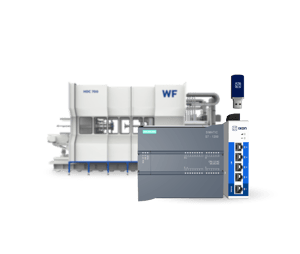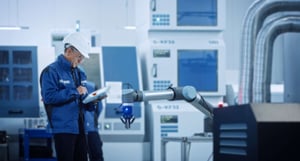- Home
- Knowledge hub
Machine Condition Monitoring – Increased Uptime and New Revenue Potentials
7 min. read
Shelly Boom
How to maintain machine health, improve service and reduce downtime with web-based machine condition monitoring and alarms.
Unplanned downtime leads to negative customer experiences and rising costs. Machine monitoring or condition monitoring of specific machine parts will increase your machine’s availability and offer revenue potentials for you as a machine builder in manufacturing.
Failures on industrial machines and systems have dramatic consequences for you and your customer. It’s crucial to keep your equipment running smoothly during and after warranty to save on costs. Risks can be reduced with machine condition monitoring and the Industrial Internet of Things (IIoT) has made it possible to monitor the machine’s condition without being physically present during up- or downtimes.
In this article we'll explain all aspects of machine condition monitoring:
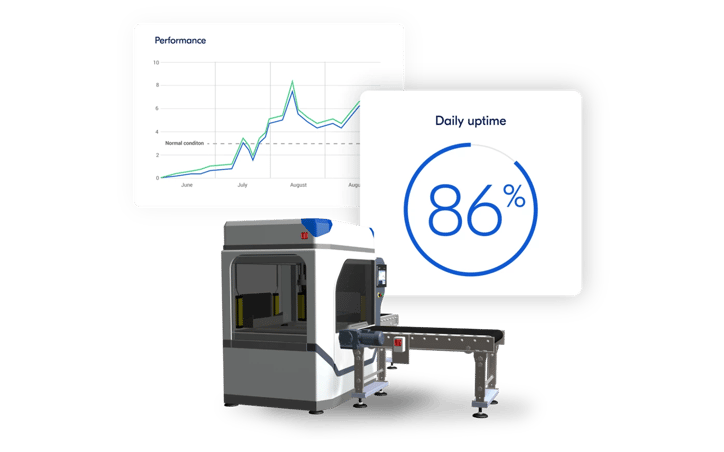 Machine condition monitoring: uptime and performance
Machine condition monitoring: uptime and performance
Machine condition monitoring is the monitoring of machinery parts during operation. By taking measurements such as vibration, pressure and temperature, you can get insights into the condition of turbines, pumps, compressors, motors, gearboxes, blowers etcetera. Measure the health of your equipment, analyse trends and determine when maintenance is required based on data generated by the machine.
Condition monitoring provides diagnostics that can determine the health of a machine based on various measured conditions, while machine monitoring provides a simple machine status: is the machine running or not?
Condition monitoring is a more mature form of machine monitoring, leveraging helpful machine data. Machine monitoring is helpful for manufacturers and machine builders as it provides machine uptime data so operators and maintenance teams can react proactively to downtime events. However, this is inadequate as it fails to provide the deeper machine analytics of condition monitoring to diagnose problems in advance and make adjustments optimise asset uptime.
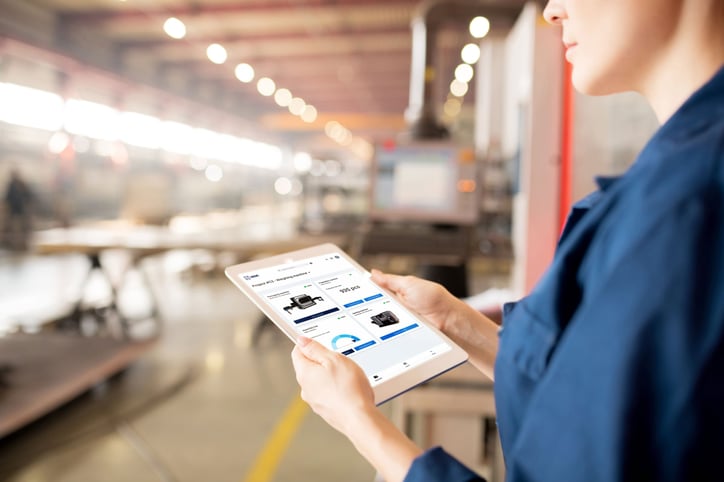 Monitoring industrial machines
Monitoring industrial machines
Condition monitoring allows machine builders to harness real-time conditions from their machines to monitor wear and tear parts and plan maintenance of their machines to ensure they are not over-maintaining or suffering from unplanned downtime.
This approach is called predictive maintenance and is cheaper and safer than preventive maintenance, where parts are replaced in advance without knowing whether this is really necessary. Predictive maintenance allows maintenance to be scheduled or other actions to be taken to prevent consequential damages.
Machine condition monitoring supports a variety of goals for machine manufacturers, including:
In summary, machine condition monitoring reduces downtime, improves the production efficiency for your customers, and helps with replacing machine spare parts just-in-time.
 Benefits of machine condition monitoring
Benefits of machine condition monitoring
Machine condition monitoring helps your customers get more out of their equipment and save on unnecessary maintenance. Accurate insight into machine performance, remote access for your field service team and solutions like augmented reality, can help you fix unplanned downtime in collaboration with operators on-site.
For the machine manufacturer it’s a great opportunity to extend their machines with a condition monitoring service. The quality and reliability of the equipment can be improved this way and the machine's uptime will increase over time which will drive a competitive advantage. It enables better decision-making for maintenance teams, as well as drives a variety of notable KPIs, including machine uptime and status (e.g. PackML state model).
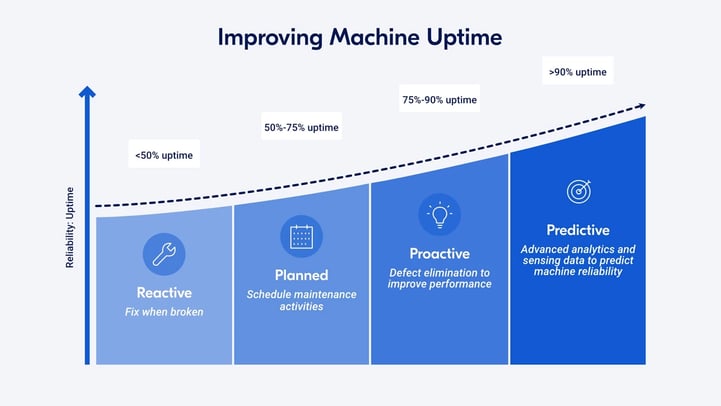 Maintenance strategies to improve machine uptime
Maintenance strategies to improve machine uptime
The use of machine condition monitoring has a positive effect on the health of a machine or the processes behind it. One major boon is increasing the longevity of equipment.
Monitoring and controlling the condition of a machine provides insight into wear & tear, damage and mechanical risks of machine parts. If a specific parameter is continuously out of range, underlying issues that could damage the machine or its components can be assessed and repaired before a downtime event or costly damage occurs.
With Industrial IoT you can go beyond VPN with in-depth condition monitoring equipment which will bring new revenue streams potentials to you as a machine builder. Condition monitoring strengthens your maintenance and reliability program by:
When internet-enabled industrial devices are connected to a cloud platform, real-time measurements are automatically aggregated around the clock. Machine data parameters are securely stored in the cloud where it can be remotely monitored and analysed by different users.
Service teams can troubleshoot machines faster using different condition monitoring devices, such as vibration sensors, temperature or power monitors. Track and compare measurements to find correlations over time and pinpoint abnormalities. With remote access they can monitor PLCs and HMIs to find and solve the problem.
Connect your machines and people with remote data access. Measurements from connected devices (PLC, robots, sensors) are automatically sent to the cloud without human intervention or error. Field service teams can access data remotely from smart devices anywhere at any time only requiring an internet connection.
An Industrial IoT solution like IXON Cloud helps machine builders to implement condition monitoring on short and long term, without big investments and technical hurdles.
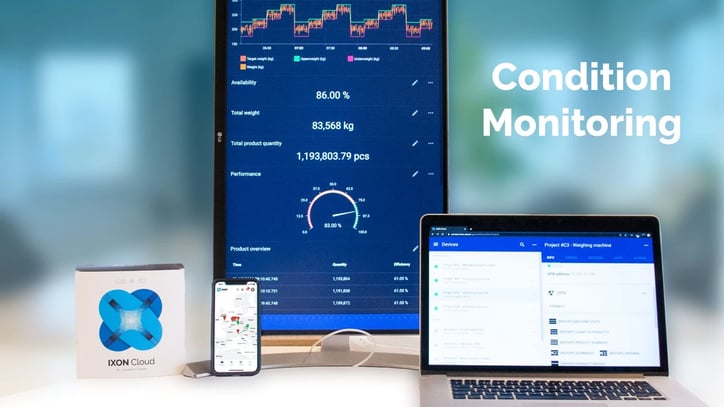 Machine Condition Monitoring with IXON Cloud
Machine Condition Monitoring with IXON Cloud
IXON Cloud’s Industrial IoT solution offers a platform for machine builders so they can leverage real-time data streaming from the machine to the cloud to perform machine condition monitoring.
IXON’s all-in-one solution with plug & play connectivity, remote access, PLC data logging, data visualisation studio and alarmings has all tools in-house to monitor and maintain machines remotely. With IIoT and web-based condition monitoring tools from IXON you increase the machine uptime throughout the life cycle of a machine.
Remote machine condition monitoring with IXON’s IIoT platform has the following advantages:
The most important benefits are that you are up and running quickly to create a solid foundation that supports your engineers to capture the most complete machine data possible.
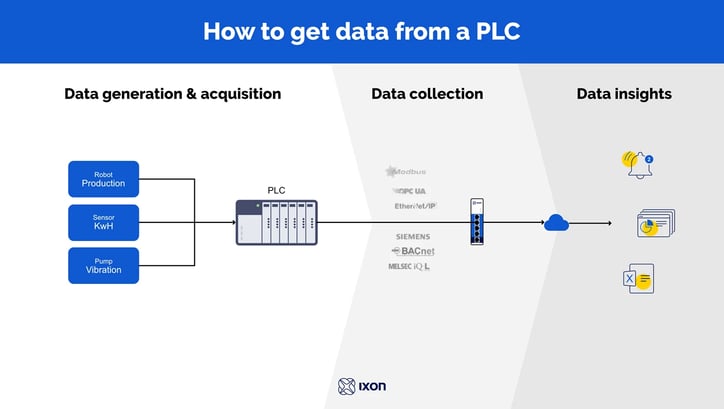 How to get data from a PLC
How to get data from a PLC
It’s easier than you think to start with a condition based monitoring program. The approach is as follows:
When using IXON Cloud, the IoT connectivity devices are fully integrated with the IXON Cloud which makes setup really easy. IXON offers a solid infrastructure and supports all modern industrial communication protocols like OPC-UA, ModBus, Siemens, BACNet to capture machine data in no time.
This IoT-driven approach makes it possible to monitor the health of machines by remotely monitoring it’s parameters.
 Monitoring the condition of a critical machine component
Monitoring the condition of a critical machine component
Condition monitoring allows you to adjust your schedules to actual performance, maximising uptime and eliminating unwanted costs. Different machines are used in the industry. That’s why you need to select the right parameters and measure them over time to monitor or deliver condition-based maintenance.
Most machine characteristics that affect uptime, availability and faults are continuously assessed over the lifetime of equipment. There are unlimited numbers of conditions that can be monitored on a machine. The IXON edge device connects directly to the PLC of a machine, giving you access to a wide variety of machine data.
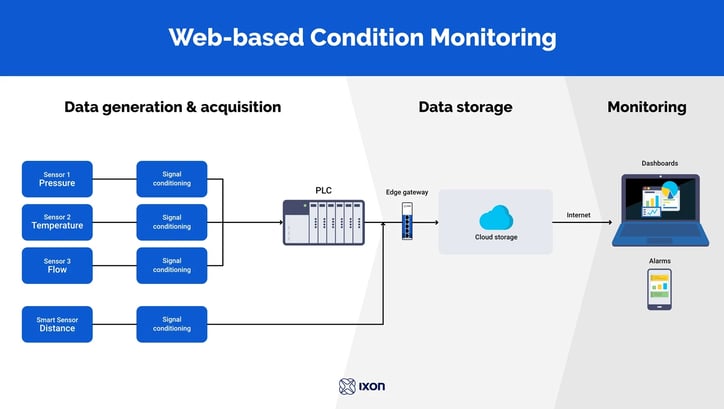 Schematic overview of web-based condition monitoring
Schematic overview of web-based condition monitoring
Machine condition data can be analysed to better understand machine health and to maintain equipment. Below are some of the conditions that can be monitored to identify machine part trends, predict failures, and roll out condition-based maintenance activities:
The IXrouter monitors those critical parameters locally and logs their condition periodically or when it changes, based on your configuration.
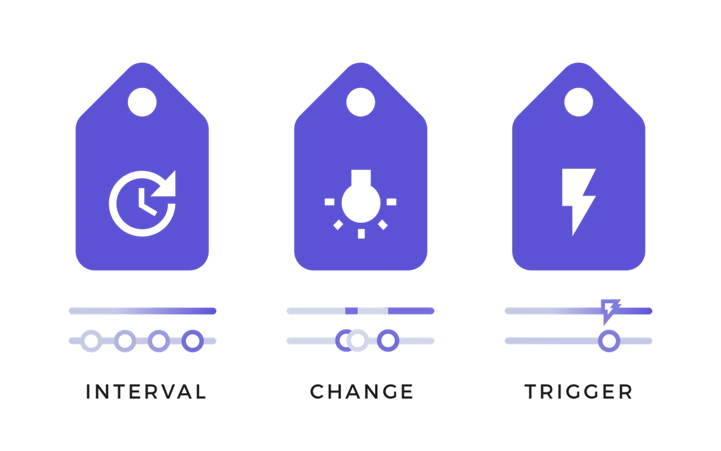 Log PLC data on interval, change or trigger
Log PLC data on interval, change or trigger
There are several possible methods for monitoring critical machinery parameters. This can take the form of continuous measurements, periodic measurements and/or remote measurements.
Periodic measurement
Periodic measurements (e.g. per millisecond, minute, hour) of parameters provide insight into the change over time. On the configured fixed interval the data is collected and a trend can be built up. From the trend and data analysis it will then become clear what caused the change so corrective measures can be advised.
On change measurements
On change measurements provide insight into the change and behavior of a parameter. For example when a boolean or fault code changes value.
On trigger measurements
With log on trigger you can configure a variable as trigger and connect other variables to this trigger. Once the trigger happens, all linked variables will be logged once. This can be used for logging multiple variables simultaneously based on a certain trigger and will allow you to look back at your data associated with the trigger in a clear and easy overview to find correlations.
The gathered data can be presented in real-time and historical dashboards, which makes analysing and predicting component failures tangible for service engineers. When the state of a parameter enters a critical value (or within a period of time), they must be informed and take action to prevent worse.
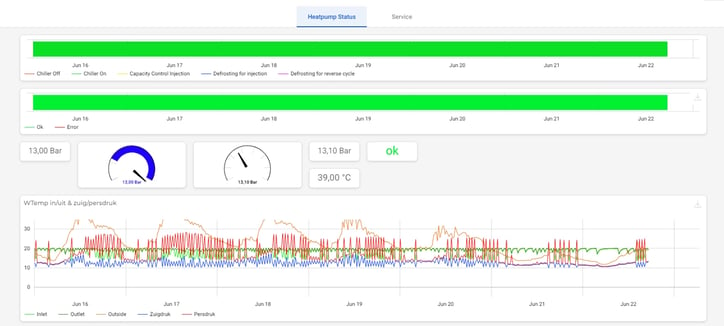 Example condition monitoring dashboard with insights into sensor parameters
Example condition monitoring dashboard with insights into sensor parameters
Once your machine data is collected, you can build your own condition monitoring dashboards using data visualisation with the key metrics of your machine. Therefore a solid and easy to use dashboard builder will help you speed up this process.
In IXON Studio you can compose your dashboards with plenty of data widgets, which represent your machine parameters in actual, average, min or max state. Or track calculated values (from one or a combination of parameters) on the PLC and present that value in your dashboard.
Create instant condition based monitoring for temperature, pressure, vibration and anything else you need to track with an unlimited number of dashboards and users.
With the IXrouter and IXON Cloud platform engineers have a turnkey solution that covers not only condition monitoring but also remote troubleshooting and alarming for all your machines in the field.
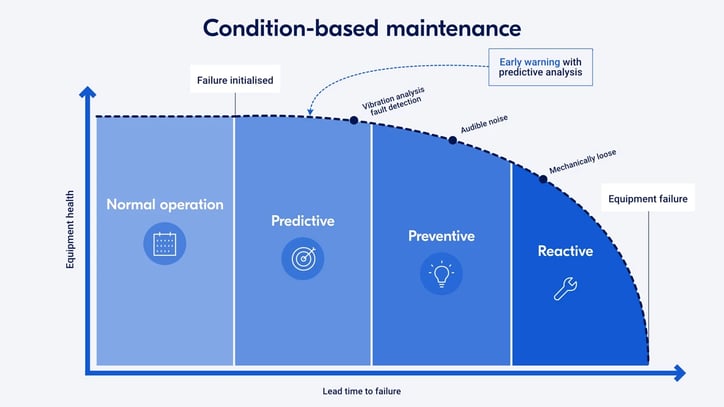 Condition-based maintenance strategy for improved machine uptime
Condition-based maintenance strategy for improved machine uptime
Condition-based monitoring drives a condition-based maintenance strategy in which maintenance is completed. When machines are indicating that there is a high chance of machine (part) failure, maintenance can be scheduled.
Early warning prevents unplanned downtime of machines and equipment. We’ve already pointed out that predictive maintenance is impossible without well-structured (historical) data. The results are displayed on your monitoring dashboard, and the values can be used to set up smart alarm triggers.
Predictive maintenance is based on data to determine the probability of a machine failure before it occurs. Triggers or conditions consist of a set of rules to match this data. When the data reaches a critical point, an alarm can be triggered to actively alert your machine or service engineer or local operator. This way you are always informed about the diagnosis of the machine wherever you want and you can identify and solve upcoming problems.
Receive industry insights and the latest IXON product updates and new features directly to your inbox through our monthly newsletter, and stay on top of market trends and insights to improve your service strategy.

